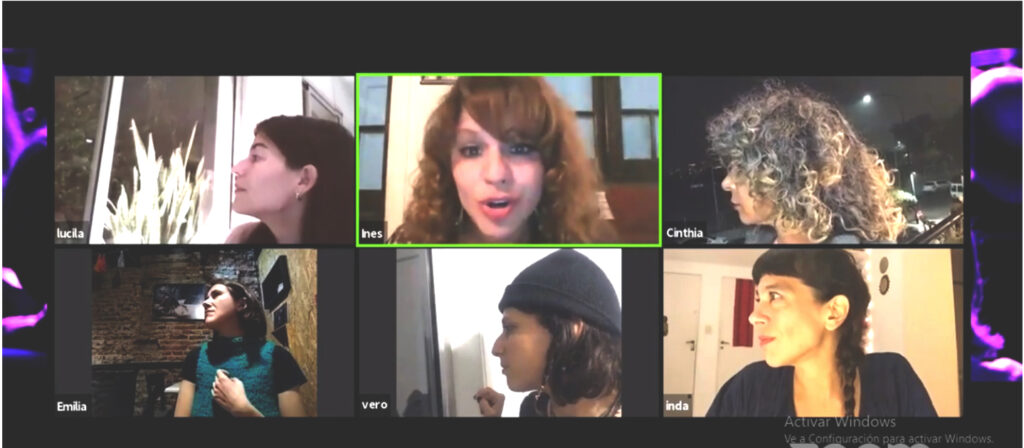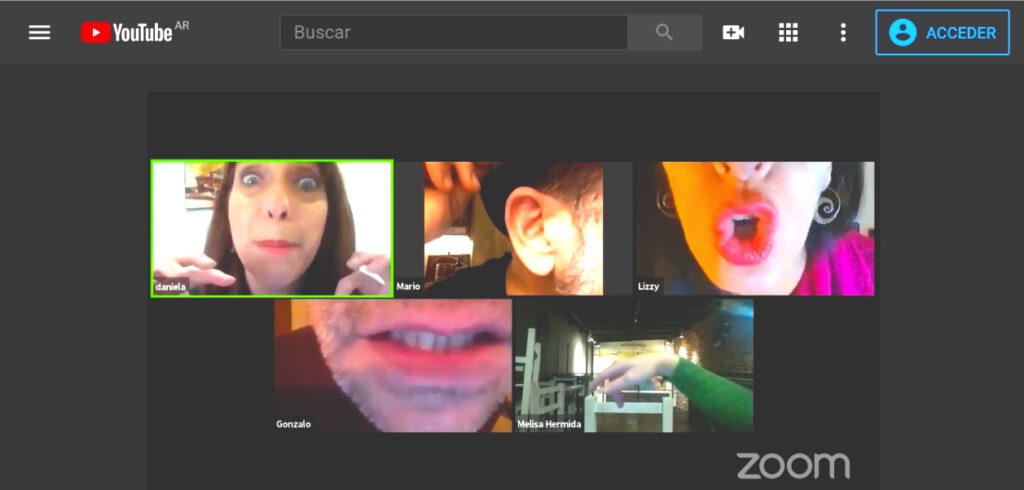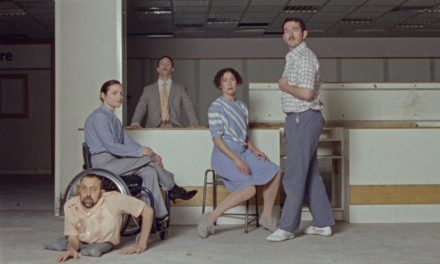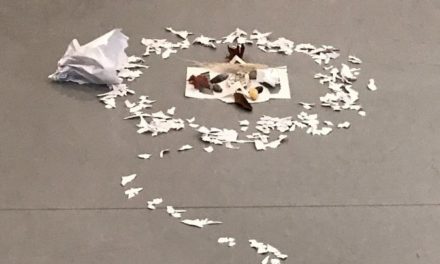The pandemic, like the tragedy of the 21st century, has a theatrical mode, and the social response to navigate it is to build an internal script to resist and survive; the situation has generated an affective atmosphere that has prompted an arc of emotional responses that range from fear to hatred but are all dominated by the drive to survive. The result is the emergence of a dramaturgy of the confinement, a constructed script that appeals to emotions with digital tools that allow for a certain level of expressive communication. In this context, the Argentinean theatrical scene (henceforce “the scene”) looks for loopholes to affirm its existence and avoid its vulnerability.
Argentinean theatre tries to find meaning improvising work and installing the testimony of the present for the memory of the future; it leaves marks. The scene tries to show the catastrophe simultaneously with its occurrence and to find a way of continuity with the previous life; it aims to exchange social, theatrical, political, and thinking energies, and overcome the impediment by finding a sense that, at the same time, makes physical and emotional survival possible. The scene manifests itself, locating the fissure between yesterday and the uncertain future in pure presentism. The impulse reveals itself to break isolation and “mobility” through production in the only possible space: the digital world. Given the forced absence of the bodies, the use of the spoken word is hundredfold (interviews, talks, conferences, meetings), and the “going” to the theatre is simulated with the sale of tickets that allow us to access the virtual transmission (with prices whose characteristic is an adaptation to what each person can afford; the economic demand has also adjusted to the new circumstances).
The scene responds from isolation and immobility using mainly verbal language, sight, and technology, which opens a flow that filters through the world provided by virtuality. Hernán Vidal, in anticipation of the “affective turn,” recommends paying attention to the emotional experience of everyday life to observe how social sensitivity is expressed through poetic language in cultural products. In this same sense, the scene’s theatricality exhibits continuity with the social theatricality; the digital scene articulates its feelings based on visual, linguistic, sound, spatial, sensorial strategies, styles, genres, and dramatic rhetoric. In the context of the tragedy, the emergence of a structure of feeling manifests itself in the persistence on being and the resistance to disappearance; this attitude manifests the social sensitivity and mimes the social theatricality that can be observed in the emergence of a shared – not uniform – imaginary that displays itself in unpopulated spaces, balconies, corners, sidewalks and on the digital screen. Theatricality emerges with a dramaturgy of the confinement in continuity with the new social theatricality characterized by distance, mediated by the presence of the television and the computer screen or the plastic of the visors, through which we look astonished at our “familiar” surroundings.
This dramaturgy that unfolds in the limited and distanced virtual space conveys an affective and living corporality. Through negotiation and looking for ways to convey meaning, and seeking a continuity of stage praxis, the scene adapts and, like any adaptation, moves away from the original and puts in question the principles of what we have considered essential elements in the theatricality of theatre: the presence of bodies and their physical exchange in person.
In this dramaturgy of the confinement, space (the screen backgrounds) ceases to be a dramatic actor who, in most cases, does not contribute to the meaning of the scene. In this space, the body appears flat and trimmed with the preeminence of the upper part (intelligence) and the effacement of the most sensual corporeality: virtuality gets along well with the intangible and the spiritual, as contrary to the bodily. The voice is a unique form of presence. The phantasmatic presence replaces the affective and corporeal and extends in circular time, shortening the spaces and inviting us to internalization and reflection.
Clipping defines this virtual pandemic poetic. The only possible movement is a flattened movement for the spectator and a restricted movement of the performers that need to respect the camera angle. The corners, windows, and balconies cut out the visual frame and set limits to our gaze and perspective. The virtual scene also reduces temporality and the flow of time in society and the stage; the past is longing, and we experience a condensed present time: in the social scene, the present is forcefully installed by the news that transmits the daily state of the pandemic and, in the virtual scene, by the need for active and present attention to the unforeseen events of technology. This new mode of theatricality trims the body.

La noche devora a sus hijos (The night devours her children). Dramaturgy and Direction by Daniel Veronese. Timbre 4/ zoom online, September 2020. Photo: sent by Maite Velo (actress).
During the 1990s and early 2000s, postmodernism as the logic of neoliberalism expressed on the stage by presenting a fragmented temporality. It broke the chronology to show the lack of meaning by articulating the scene’s structure with the dissolution of social and economic systems. Today, to escape from the pandemic’s immobility seems to require adopting a fragmentary perspective of the scene, with a fragmentation of space and the acting body. However, unlike the ‘90s, there is no temporal fragmentation; virtuality simulates simultaneity. Everything seems to happen there simultaneously, and forever, we can start over and go back to the beginning and reach the end again. In virtual reality, as in everyday life, the time has become circular. The order of the calendar seems to have disappeared.
Death stalking preaches a dramaturgy of bodily immobility—all seated in front of the screen—seeking to find compensation in the digital image with an emphasis on words, sight, and listening. Like the social tragedy only observable through the screen, the scene is untouchable and odorless, only visible and listenable. Like the bodies affected by the coronavirus, pandemic poetics have lost access to the senses of touch, taste, and smell.
Would it be possible to think that this poetic of isolation forced by the obligatory nature of social distancing works in an analogous and intensified way to produce Brechtian distancing? In Brecht’s theory, the distancing was produced only by dramaturgical techniques; today, the scene produces the distancing effect by an artifact and the threat of Covid-19, new mediations that give evidence of the scene’s constructed character creating a more radical distancing.
The virtual scene seems to make the production of “realistic” mimetic theatre impossible; even if the scene tried to reproduce everyday life, it would be impossible to accept it as “real”; the camera demolishes any possibility of illusionism despite the fact that on each screen we witness the everyday life and the “real” space of the actor/actress’s life. Paradoxically, this “reality” highlights the artificiality of theatrical production. This harsh and radical distancing denatures the scene and does not allow an Aristotelian catharsis either. However, in its structure, this poetics gives us another reality: it makes the dangerousness of the virus palpable and shows the vulnerability and impediments that restrict bodies. In this sense, and as Adorno would say, it is deeply political because it makes visible, in its structure, the invisible presence of danger, the impediment of bodies, and indirectly reminds us continually of the presence of the virus.
Furthermore, it is vital to remember Frederick Jameson, who pointed out communication as the only positive aspect of globalization, and Juan Villegas, who proposed communication as the core of theatricality. The present experience seems to confirm this, since communication allows us to continue trying to diagram a dramaturgical structure of the confinement with pandemic poetics. Communication is the essential ingredient for the digital scene, and it is the condition of possibility of its very existence and its attempts to persist in it.
We frequently hear that “the theatre needs bodies to exist,” I ask myself: Does the pandemic’s theatre not have bodies? Isn’t the defense of the bodies what drives it? Are we facing a new modality that will force us to rethink what it does to the theatrical? A theatricality whose essential point may be the ability to communicate and whose purpose is to defend the action, life, and emphasizing being?
After a few months of this situation, the theatre producers in Argentina tried to continue with specific digital world activities that get as close as possible to the theatrical experience. In these cases, the actors’ bodies gets separated into divided, individualized spaces, fixed in precise limits; neither viewers nor actors can see or move beyond that frame. This scene takes place to live in the “other scene” and tries to transmit the action, but its digital presence is limited to narrative and virtual mode, and the performance is restricted; the bodies that act do so in front of a camera adding one more mediation to a representation that acquires a more exceptional thickness and density. Emotions make their way exclusively through voice, look, and facial gestures. This new theatricality has no definition yet; it seems to be a new form that tries to cross pandemic boundaries, outwit the virus and survive.
Let us exemplify the above with The Night Devours Their Children by Daniel Veronese that was rehearsed to premiere last April at Timbre 4 by the director and the performers. Veronese and the group involved decided to transform and adapt it to an online format. In this innovative adaptation, there are several accomplishments. The zoom windows give the impression that the communication between the actors goes beyond the digital scene, an effect achieved by the gaze, the gestures, and the voice. The actors respond, get excited in unison, say the texts in a chorus of voices, and make simultaneous gestures, looking in the same direction. The text, in the plurality of voices, intertwines and weaves a communication connection beyond digital frames. The viewer manages to perceive what seems to be actors shared affective plural corporality and reactions. Facial gestures predominate, especially the gaze directed at the viewer/camera during the performance with the voices overlapping and sometimes join in the spoken chorus; there is also a gestural chorus that opens communication channels that seem to go beyond the digital cut. The chorus of gestures, looks, and voices gives the “spectator” the feeling that there is a single-stage space with expressive acting and movement exchange without the need for costumes, makeup, or masks. However, despite scenic “realism,” the background of the private spaces from which the actors transmit, and the evidence of the framework that separates them highlights the dense representation in virtuality. We would perhaps say then that it is a non-mimetic representation with realistic elements whose naturalizing effect cannot overcome the artificial digital-theatrical construction.

La noche devora a sus hijos (The night devours her children). Dramaturgy and Direction by Daniel Veronese. Timbre 4/ zoom online, September 2020. Photo: sent by Maite Velo (actress).
The theatre continues to be the sole power of its ubiquitous presence. Maybe this time has given birth to discoveries that perhaps imply new possibilities for theatre. Do we cling to established notions? Are the features that define the theatre story centered? We prefer to leave the question open with the doubt articulated. In any case, the theatre players continue trying to capture this incredible moment to forge something beautiful, new, and hopeful. However, this tragedy’s true magnitude’s impact on the theatre will only be understood when we look back and reflect on what has happened to the world and the stage.
This post was written by the author in their personal capacity.The opinions expressed in this article are the author’s own and do not reflect the view of The Theatre Times, their staff or collaborators.
This post was written by Lola Proaño Gomez.
The views expressed here belong to the author and do not necessarily reflect our views and opinions.


















